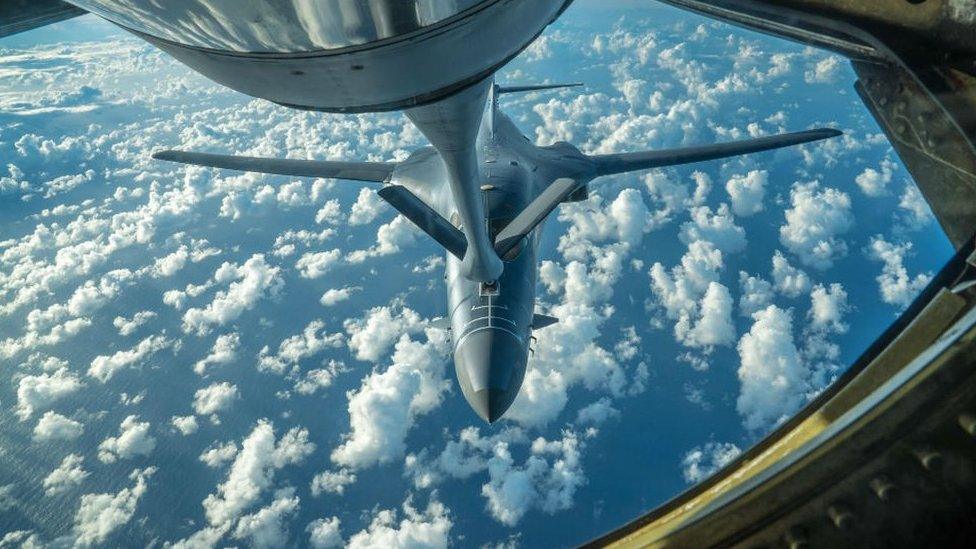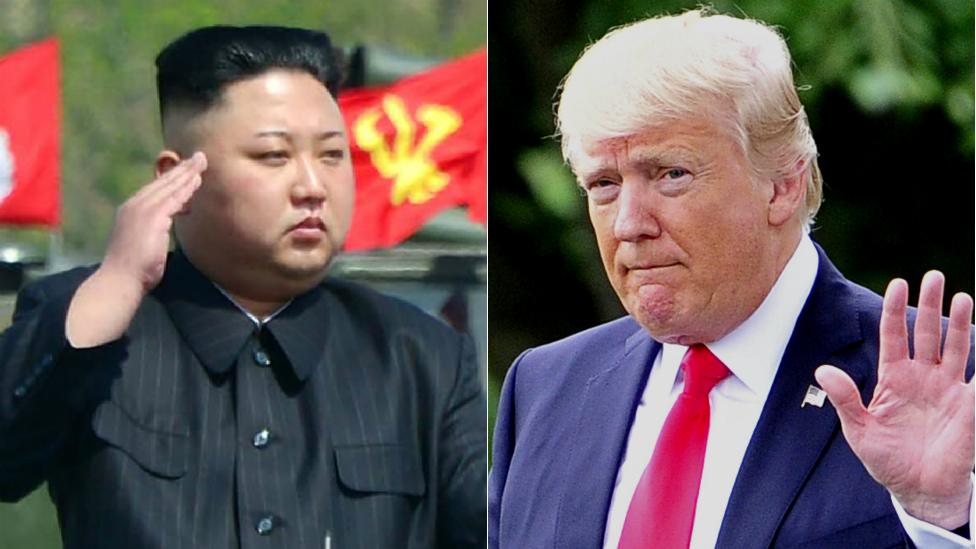North Korea crisis: Where to now after 'fire and fury'?
- Published

US bombers recently flew a mission over the Korean peninsula as a warning to Pyongyang
In the escalating war of words between the United States and North Korea, one assumes that Kim Jong-un's propaganda machine is now working overtime.
After threatening revenge "a thousand fold" in response to United Nations sanctions over its destabilising lurch towards a nuclear capability, how can Pyongyang top President Donald Trump's return volley, through which he pledged "fire and fury like the world has never seen" if North Korea continues to threaten the United States?
First, let's put this latest exchange in context. How much of this have we experienced before? And to what extent are we beginning to break new and dangerous ground?
Terminology surrounding North Korea has always seemed backwards. The end of the Korean War in 1953 technically represented a cessation of hostilities between the two sides. But in reality there has been open hostility ever since.
President Trump threatened a response 'like the world has never seen'
The US and North Korea came very close to armed conflict in 1994 after Pyongyang refused to allow international inspectors access to its nuclear facilities as required under the Nuclear Non-Proliferation Treaty.
That crisis was resolved diplomatically, but it set the stage for a two-decade cat and mouse game where North Korea paid lip service to its pledge to denuclearise but kept its options open to build an actual weapon and the means to deliver it.
Over time, while the international community offered North Korea normal relations in return for denuclearisation, Pyongyang wanted normal relations and nuclear weapons. Without admitting it, the US policy became containment, preventing North Korea from exporting its nuclear know-how while hoping that its erratic regime would implode before it actually obtained a nuclear deterrent.
Ultimate insurance policy
In recent years, two key developments changed the basic contours of the North Korea problem.
First, the removals of Saddam Hussein by the Bush administration and Muammar Gaddafi by the Obama administration - two leaders who contemplated nuclear weapons but didn't actually build them - led Pyongyang to a simple conclusion: an actual nuclear capability is the ultimate regime insurance policy.
And second, Kim Jong-il passed away in late 2011. The elder Kim was sufficiently deferential to his primary benefactor, China, that he maintained plausible deniability as to North Korea's actual nuclear capability. Kim Jong-un, his son and successor, has abandoned all pretence and is openly racing to obtain a demonstrated nuclear deterrent.

There is growing alarm in South Korea as tensions rise between Washington and Pyongyang
The Trump administration must decide what it can and cannot live with, and what to do about a situation that is rapidly moving from bad to worse.
To his credit, even as a candidate, President Trump placed the North Korea issue at or near the top of his list of national security concerns. And he has consistently called on China, North Korea's leading trading partner, to do more to rein in its client state.
On the other hand, Mr Trump has underestimated the risk and complexity surrounding the North Korea problem. While he vowed early in his tenure that he would solve it one way or another, he ignored the reality that there are no good policy options available.
At one level, President Trump's threat of fire and fury is not new. In many different forms, albeit not as colourful, the US has always said that if North Korea ever attacks, the regime will cease to exist. That said, Mr Trump's rhetoric seemed to suggest that he was prepared to take pre-emptive action if North Korea gets closer to an actual nuclear deterrent.
But any use of force immediately places hundreds of thousands of South Koreans and Japanese citizens at risk. North Korea will almost certainly respond to a pre-emptive attack.
What is different about this cycle is the lack of a diplomatic process that could serve as a firebreak.
Secretary of State Rex Tillerson said in a recent media briefing that the United States is open to dialogue with North Korea, provided talks are about ending missile tests and giving up nuclear weapons. Pyongyang, even as it confronts new sanctions, is unlikely to agree to those conditions.
While China welcomed Mr Tillerson's gesture, North Korea's young leader doesn't seem to care what Beijing thinks. And the next move is his.
The danger is that at some point, the over-heated rhetoric creates an action-reaction cycle without an obvious reverse gear.
They fire a missile. We slap on more sanctions. They promise revenge. We declare these threats intolerable. They fire another missile. Then what?
This is where rhetoric meets strategy. But it's unclear if there is one behind Trump's fire and fury.
PJ Crowley is a former US Assistant Secretary of State and author of Red Line: America Foreign Policy in a Time of Fractured Politics and Failing States.
- Published1 May 2017

- Published8 August 2017

- Published10 August 2017
- Published4 July 2017
- Published4 July 2017
